Financial Reporting Analysis: Marks & Spencer and IFRS Compliance
VerifiedAdded on 2020/12/29
|21
|4358
|366
Report
AI Summary
This report provides a comprehensive overview of financial reporting, beginning with its context and purpose, emphasizing its role in providing stakeholders with insights into a business's financial performance and position. It delves into the conceptual and regulatory frameworks, including key principles such as understandability, relevance, reliability, and comparability. The report identifies both internal and external stakeholders, detailing how they benefit from financial information. It then examines the value of financial reporting in meeting organizational objectives, such as maximizing profits and attracting investors. The main financial statements as per IAS 1 are discussed, including the statement of profit and loss, statement of changes in equity, and the balance sheet, and the importance of the cash flow statement. A case study of Marks and Spencer's financial statements is included, along with a comparison between International Accounting Standards (IAS) and International Financial Reporting Standards (IFRS). The report concludes with a discussion of the benefits of IFRS and the varying degrees of compliance with IFRS across organizations globally.
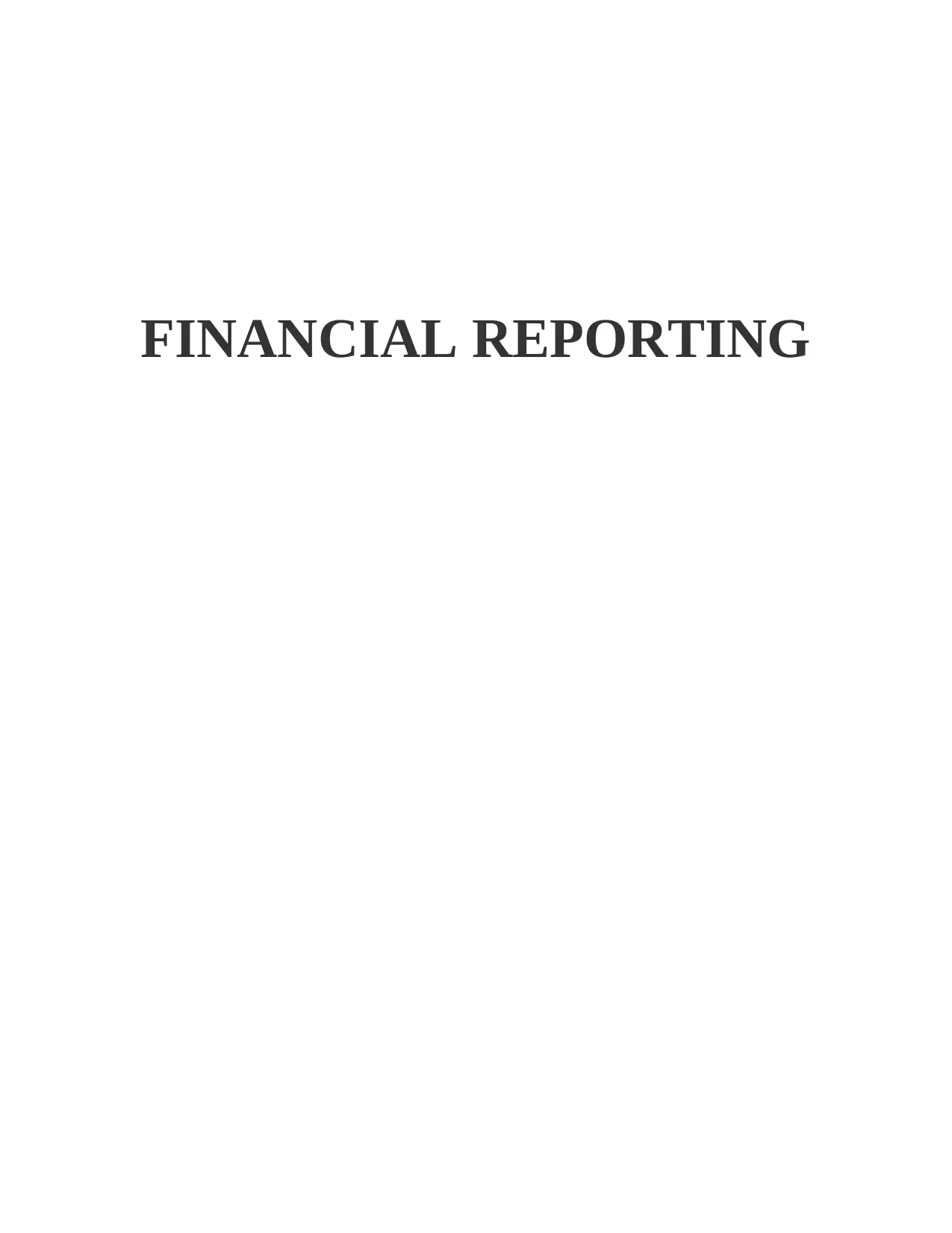
FINANCIAL REPORTING
Paraphrase This Document
Need a fresh take? Get an instant paraphrase of this document with our AI Paraphraser
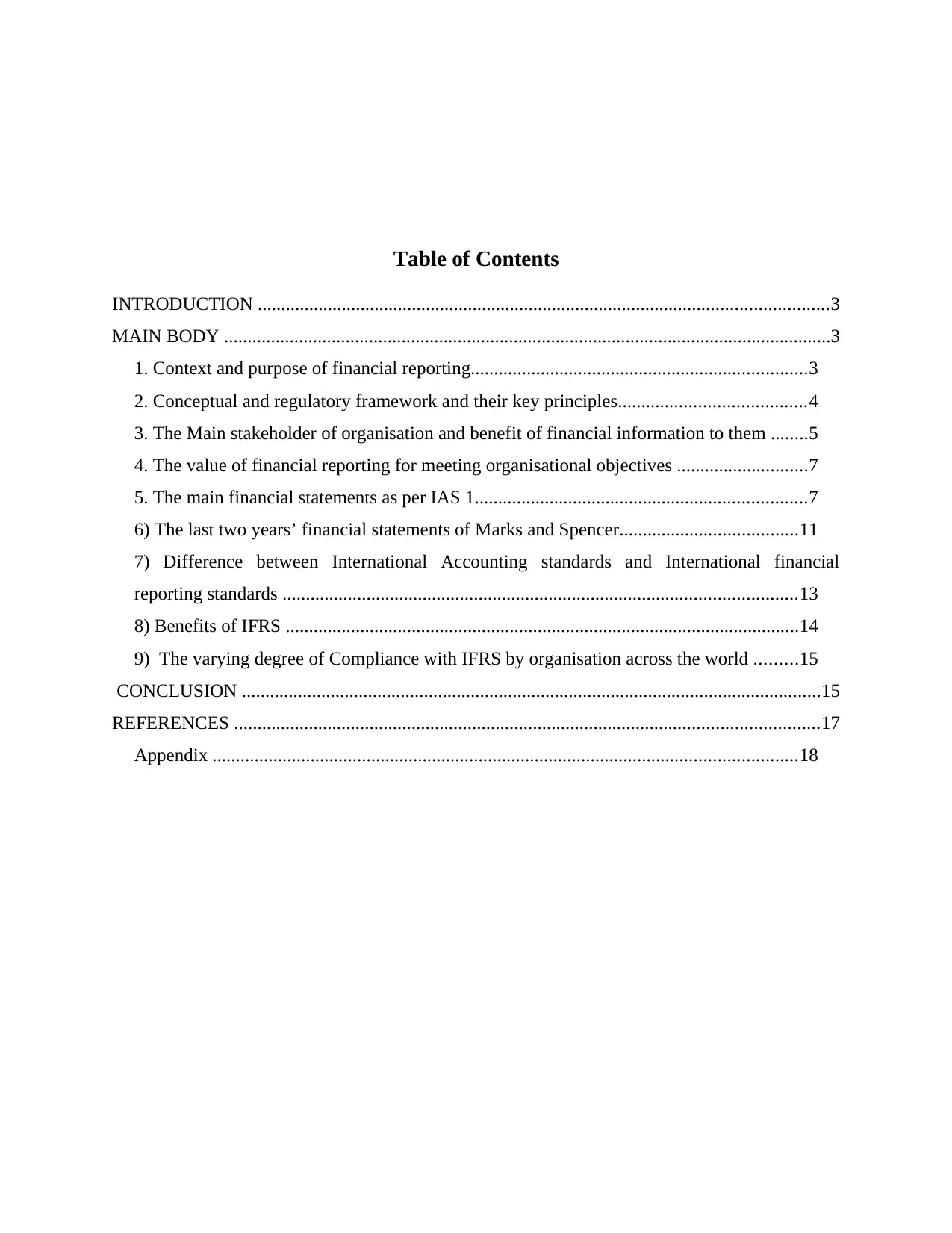
Table of Contents
INTRODUCTION ..........................................................................................................................3
MAIN BODY ..................................................................................................................................3
1. Context and purpose of financial reporting........................................................................3
2. Conceptual and regulatory framework and their key principles........................................4
3. The Main stakeholder of organisation and benefit of financial information to them ........5
4. The value of financial reporting for meeting organisational objectives ............................7
5. The main financial statements as per IAS 1.......................................................................7
6) The last two years’ financial statements of Marks and Spencer......................................11
7) Difference between International Accounting standards and International financial
reporting standards ..............................................................................................................13
8) Benefits of IFRS ..............................................................................................................14
9) The varying degree of Compliance with IFRS by organisation across the world .........15
CONCLUSION ............................................................................................................................15
REFERENCES .............................................................................................................................17
Appendix .............................................................................................................................18
INTRODUCTION ..........................................................................................................................3
MAIN BODY ..................................................................................................................................3
1. Context and purpose of financial reporting........................................................................3
2. Conceptual and regulatory framework and their key principles........................................4
3. The Main stakeholder of organisation and benefit of financial information to them ........5
4. The value of financial reporting for meeting organisational objectives ............................7
5. The main financial statements as per IAS 1.......................................................................7
6) The last two years’ financial statements of Marks and Spencer......................................11
7) Difference between International Accounting standards and International financial
reporting standards ..............................................................................................................13
8) Benefits of IFRS ..............................................................................................................14
9) The varying degree of Compliance with IFRS by organisation across the world .........15
CONCLUSION ............................................................................................................................15
REFERENCES .............................................................................................................................17
Appendix .............................................................................................................................18

⊘ This is a preview!⊘
Do you want full access?
Subscribe today to unlock all pages.

Trusted by 1+ million students worldwide
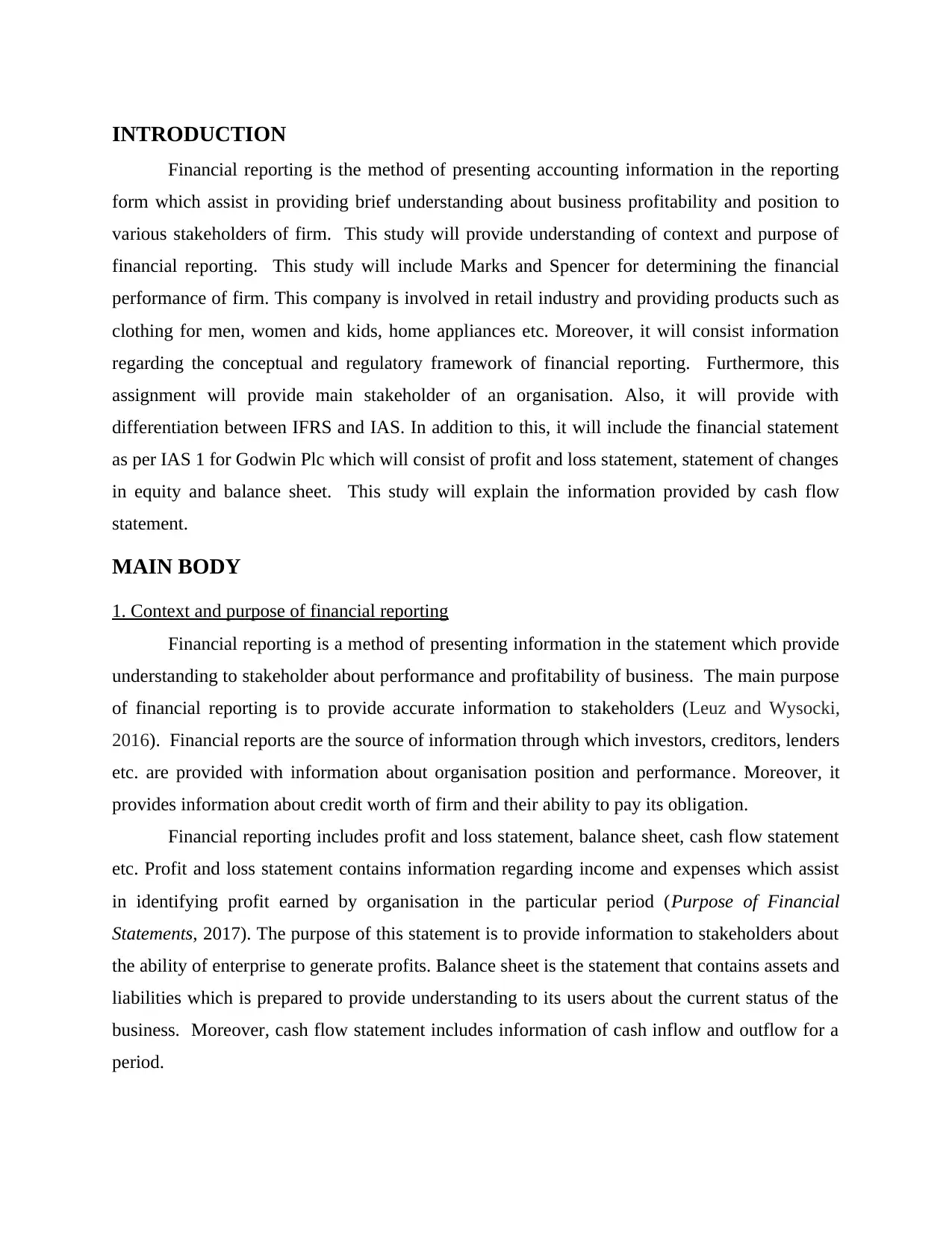
INTRODUCTION
Financial reporting is the method of presenting accounting information in the reporting
form which assist in providing brief understanding about business profitability and position to
various stakeholders of firm. This study will provide understanding of context and purpose of
financial reporting. This study will include Marks and Spencer for determining the financial
performance of firm. This company is involved in retail industry and providing products such as
clothing for men, women and kids, home appliances etc. Moreover, it will consist information
regarding the conceptual and regulatory framework of financial reporting. Furthermore, this
assignment will provide main stakeholder of an organisation. Also, it will provide with
differentiation between IFRS and IAS. In addition to this, it will include the financial statement
as per IAS 1 for Godwin Plc which will consist of profit and loss statement, statement of changes
in equity and balance sheet. This study will explain the information provided by cash flow
statement.
MAIN BODY
1. Context and purpose of financial reporting
Financial reporting is a method of presenting information in the statement which provide
understanding to stakeholder about performance and profitability of business. The main purpose
of financial reporting is to provide accurate information to stakeholders (Leuz and Wysocki,
2016). Financial reports are the source of information through which investors, creditors, lenders
etc. are provided with information about organisation position and performance. Moreover, it
provides information about credit worth of firm and their ability to pay its obligation.
Financial reporting includes profit and loss statement, balance sheet, cash flow statement
etc. Profit and loss statement contains information regarding income and expenses which assist
in identifying profit earned by organisation in the particular period (Purpose of Financial
Statements, 2017). The purpose of this statement is to provide information to stakeholders about
the ability of enterprise to generate profits. Balance sheet is the statement that contains assets and
liabilities which is prepared to provide understanding to its users about the current status of the
business. Moreover, cash flow statement includes information of cash inflow and outflow for a
period.
Financial reporting is the method of presenting accounting information in the reporting
form which assist in providing brief understanding about business profitability and position to
various stakeholders of firm. This study will provide understanding of context and purpose of
financial reporting. This study will include Marks and Spencer for determining the financial
performance of firm. This company is involved in retail industry and providing products such as
clothing for men, women and kids, home appliances etc. Moreover, it will consist information
regarding the conceptual and regulatory framework of financial reporting. Furthermore, this
assignment will provide main stakeholder of an organisation. Also, it will provide with
differentiation between IFRS and IAS. In addition to this, it will include the financial statement
as per IAS 1 for Godwin Plc which will consist of profit and loss statement, statement of changes
in equity and balance sheet. This study will explain the information provided by cash flow
statement.
MAIN BODY
1. Context and purpose of financial reporting
Financial reporting is a method of presenting information in the statement which provide
understanding to stakeholder about performance and profitability of business. The main purpose
of financial reporting is to provide accurate information to stakeholders (Leuz and Wysocki,
2016). Financial reports are the source of information through which investors, creditors, lenders
etc. are provided with information about organisation position and performance. Moreover, it
provides information about credit worth of firm and their ability to pay its obligation.
Financial reporting includes profit and loss statement, balance sheet, cash flow statement
etc. Profit and loss statement contains information regarding income and expenses which assist
in identifying profit earned by organisation in the particular period (Purpose of Financial
Statements, 2017). The purpose of this statement is to provide information to stakeholders about
the ability of enterprise to generate profits. Balance sheet is the statement that contains assets and
liabilities which is prepared to provide understanding to its users about the current status of the
business. Moreover, cash flow statement includes information of cash inflow and outflow for a
period.
Paraphrase This Document
Need a fresh take? Get an instant paraphrase of this document with our AI Paraphraser
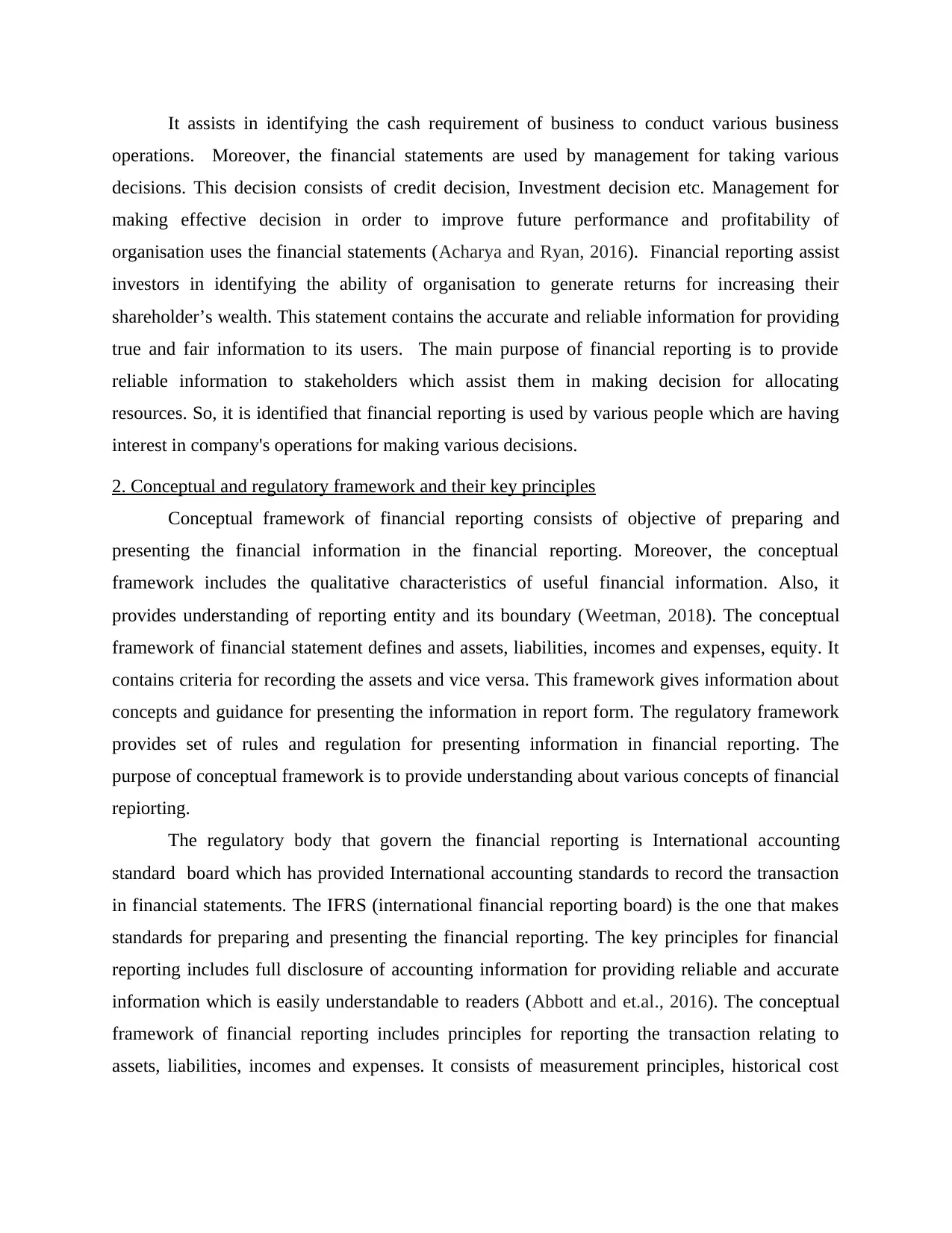
It assists in identifying the cash requirement of business to conduct various business
operations. Moreover, the financial statements are used by management for taking various
decisions. This decision consists of credit decision, Investment decision etc. Management for
making effective decision in order to improve future performance and profitability of
organisation uses the financial statements (Acharya and Ryan, 2016). Financial reporting assist
investors in identifying the ability of organisation to generate returns for increasing their
shareholder’s wealth. This statement contains the accurate and reliable information for providing
true and fair information to its users. The main purpose of financial reporting is to provide
reliable information to stakeholders which assist them in making decision for allocating
resources. So, it is identified that financial reporting is used by various people which are having
interest in company's operations for making various decisions.
2. Conceptual and regulatory framework and their key principles
Conceptual framework of financial reporting consists of objective of preparing and
presenting the financial information in the financial reporting. Moreover, the conceptual
framework includes the qualitative characteristics of useful financial information. Also, it
provides understanding of reporting entity and its boundary (Weetman, 2018). The conceptual
framework of financial statement defines and assets, liabilities, incomes and expenses, equity. It
contains criteria for recording the assets and vice versa. This framework gives information about
concepts and guidance for presenting the information in report form. The regulatory framework
provides set of rules and regulation for presenting information in financial reporting. The
purpose of conceptual framework is to provide understanding about various concepts of financial
repiorting.
The regulatory body that govern the financial reporting is International accounting
standard board which has provided International accounting standards to record the transaction
in financial statements. The IFRS (international financial reporting board) is the one that makes
standards for preparing and presenting the financial reporting. The key principles for financial
reporting includes full disclosure of accounting information for providing reliable and accurate
information which is easily understandable to readers (Abbott and et.al., 2016). The conceptual
framework of financial reporting includes principles for reporting the transaction relating to
assets, liabilities, incomes and expenses. It consists of measurement principles, historical cost
operations. Moreover, the financial statements are used by management for taking various
decisions. This decision consists of credit decision, Investment decision etc. Management for
making effective decision in order to improve future performance and profitability of
organisation uses the financial statements (Acharya and Ryan, 2016). Financial reporting assist
investors in identifying the ability of organisation to generate returns for increasing their
shareholder’s wealth. This statement contains the accurate and reliable information for providing
true and fair information to its users. The main purpose of financial reporting is to provide
reliable information to stakeholders which assist them in making decision for allocating
resources. So, it is identified that financial reporting is used by various people which are having
interest in company's operations for making various decisions.
2. Conceptual and regulatory framework and their key principles
Conceptual framework of financial reporting consists of objective of preparing and
presenting the financial information in the financial reporting. Moreover, the conceptual
framework includes the qualitative characteristics of useful financial information. Also, it
provides understanding of reporting entity and its boundary (Weetman, 2018). The conceptual
framework of financial statement defines and assets, liabilities, incomes and expenses, equity. It
contains criteria for recording the assets and vice versa. This framework gives information about
concepts and guidance for presenting the information in report form. The regulatory framework
provides set of rules and regulation for presenting information in financial reporting. The
purpose of conceptual framework is to provide understanding about various concepts of financial
repiorting.
The regulatory body that govern the financial reporting is International accounting
standard board which has provided International accounting standards to record the transaction
in financial statements. The IFRS (international financial reporting board) is the one that makes
standards for preparing and presenting the financial reporting. The key principles for financial
reporting includes full disclosure of accounting information for providing reliable and accurate
information which is easily understandable to readers (Abbott and et.al., 2016). The conceptual
framework of financial reporting includes principles for reporting the transaction relating to
assets, liabilities, incomes and expenses. It consists of measurement principles, historical cost
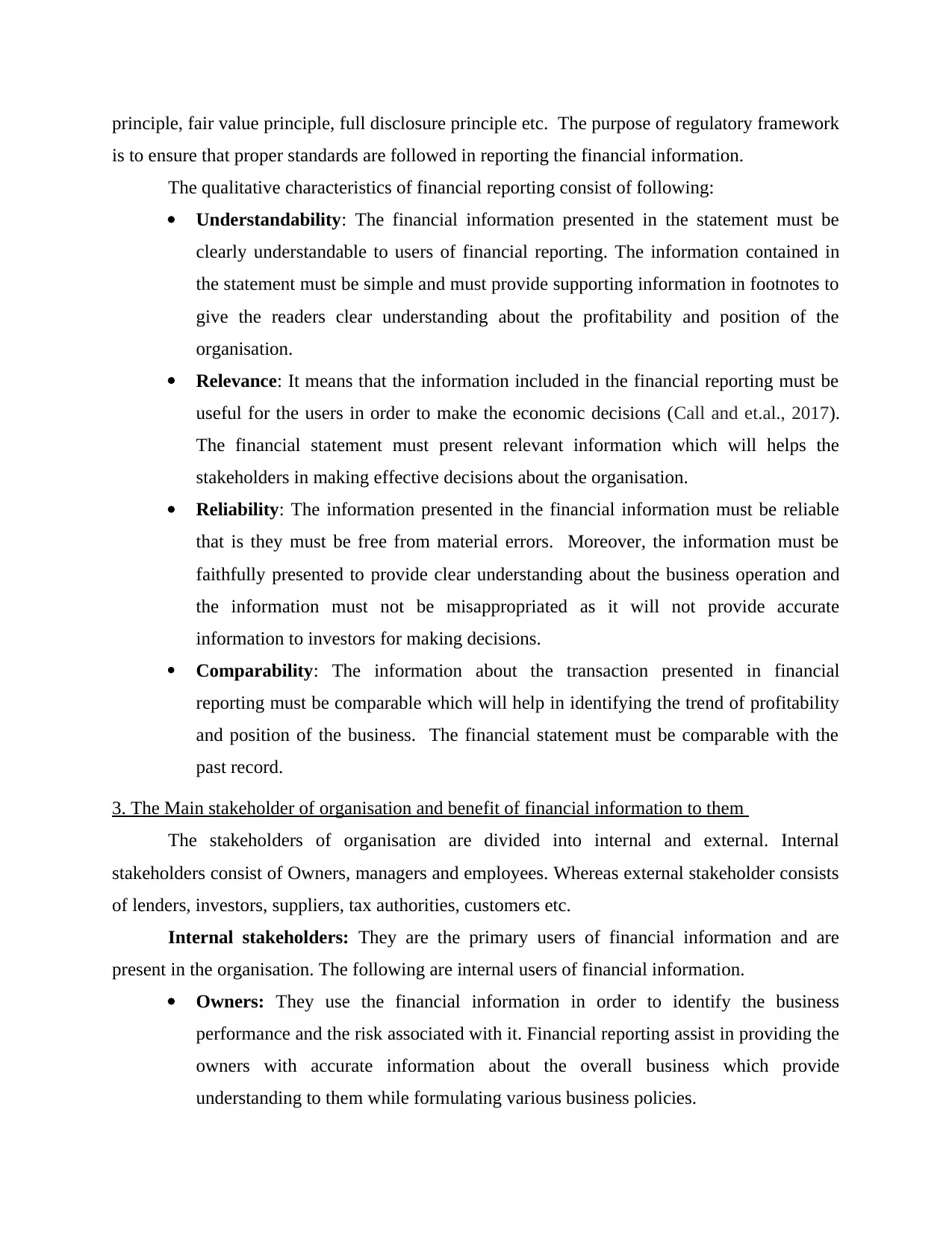
principle, fair value principle, full disclosure principle etc. The purpose of regulatory framework
is to ensure that proper standards are followed in reporting the financial information.
The qualitative characteristics of financial reporting consist of following:
Understandability: The financial information presented in the statement must be
clearly understandable to users of financial reporting. The information contained in
the statement must be simple and must provide supporting information in footnotes to
give the readers clear understanding about the profitability and position of the
organisation.
Relevance: It means that the information included in the financial reporting must be
useful for the users in order to make the economic decisions (Call and et.al., 2017).
The financial statement must present relevant information which will helps the
stakeholders in making effective decisions about the organisation.
Reliability: The information presented in the financial information must be reliable
that is they must be free from material errors. Moreover, the information must be
faithfully presented to provide clear understanding about the business operation and
the information must not be misappropriated as it will not provide accurate
information to investors for making decisions.
Comparability: The information about the transaction presented in financial
reporting must be comparable which will help in identifying the trend of profitability
and position of the business. The financial statement must be comparable with the
past record.
3. The Main stakeholder of organisation and benefit of financial information to them
The stakeholders of organisation are divided into internal and external. Internal
stakeholders consist of Owners, managers and employees. Whereas external stakeholder consists
of lenders, investors, suppliers, tax authorities, customers etc.
Internal stakeholders: They are the primary users of financial information and are
present in the organisation. The following are internal users of financial information.
Owners: They use the financial information in order to identify the business
performance and the risk associated with it. Financial reporting assist in providing the
owners with accurate information about the overall business which provide
understanding to them while formulating various business policies.
is to ensure that proper standards are followed in reporting the financial information.
The qualitative characteristics of financial reporting consist of following:
Understandability: The financial information presented in the statement must be
clearly understandable to users of financial reporting. The information contained in
the statement must be simple and must provide supporting information in footnotes to
give the readers clear understanding about the profitability and position of the
organisation.
Relevance: It means that the information included in the financial reporting must be
useful for the users in order to make the economic decisions (Call and et.al., 2017).
The financial statement must present relevant information which will helps the
stakeholders in making effective decisions about the organisation.
Reliability: The information presented in the financial information must be reliable
that is they must be free from material errors. Moreover, the information must be
faithfully presented to provide clear understanding about the business operation and
the information must not be misappropriated as it will not provide accurate
information to investors for making decisions.
Comparability: The information about the transaction presented in financial
reporting must be comparable which will help in identifying the trend of profitability
and position of the business. The financial statement must be comparable with the
past record.
3. The Main stakeholder of organisation and benefit of financial information to them
The stakeholders of organisation are divided into internal and external. Internal
stakeholders consist of Owners, managers and employees. Whereas external stakeholder consists
of lenders, investors, suppliers, tax authorities, customers etc.
Internal stakeholders: They are the primary users of financial information and are
present in the organisation. The following are internal users of financial information.
Owners: They use the financial information in order to identify the business
performance and the risk associated with it. Financial reporting assist in providing the
owners with accurate information about the overall business which provide
understanding to them while formulating various business policies.
⊘ This is a preview!⊘
Do you want full access?
Subscribe today to unlock all pages.

Trusted by 1+ million students worldwide
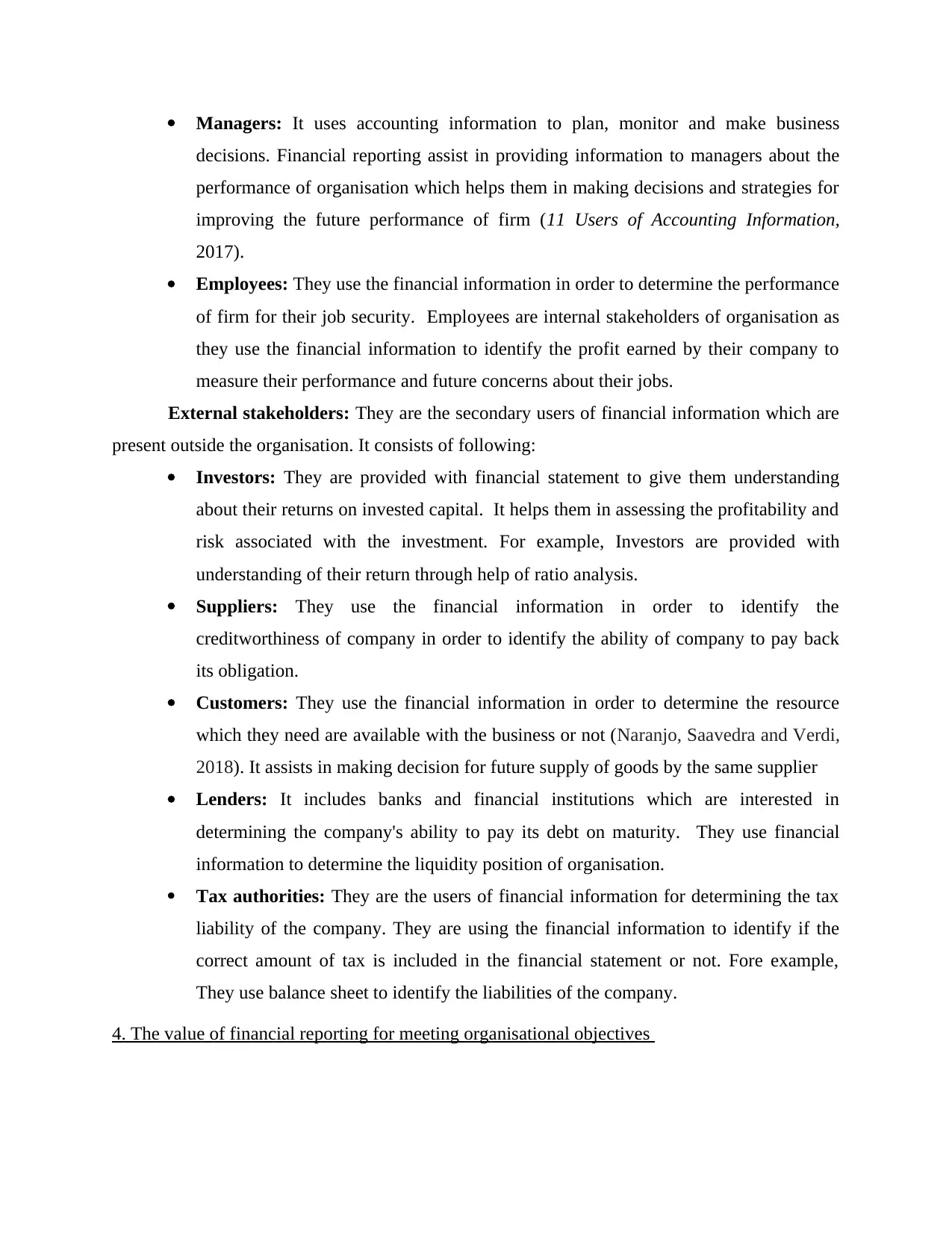
Managers: It uses accounting information to plan, monitor and make business
decisions. Financial reporting assist in providing information to managers about the
performance of organisation which helps them in making decisions and strategies for
improving the future performance of firm (11 Users of Accounting Information,
2017).
Employees: They use the financial information in order to determine the performance
of firm for their job security. Employees are internal stakeholders of organisation as
they use the financial information to identify the profit earned by their company to
measure their performance and future concerns about their jobs.
External stakeholders: They are the secondary users of financial information which are
present outside the organisation. It consists of following:
Investors: They are provided with financial statement to give them understanding
about their returns on invested capital. It helps them in assessing the profitability and
risk associated with the investment. For example, Investors are provided with
understanding of their return through help of ratio analysis.
Suppliers: They use the financial information in order to identify the
creditworthiness of company in order to identify the ability of company to pay back
its obligation.
Customers: They use the financial information in order to determine the resource
which they need are available with the business or not (Naranjo, Saavedra and Verdi,
2018). It assists in making decision for future supply of goods by the same supplier
Lenders: It includes banks and financial institutions which are interested in
determining the company's ability to pay its debt on maturity. They use financial
information to determine the liquidity position of organisation.
Tax authorities: They are the users of financial information for determining the tax
liability of the company. They are using the financial information to identify if the
correct amount of tax is included in the financial statement or not. Fore example,
They use balance sheet to identify the liabilities of the company.
4. The value of financial reporting for meeting organisational objectives
decisions. Financial reporting assist in providing information to managers about the
performance of organisation which helps them in making decisions and strategies for
improving the future performance of firm (11 Users of Accounting Information,
2017).
Employees: They use the financial information in order to determine the performance
of firm for their job security. Employees are internal stakeholders of organisation as
they use the financial information to identify the profit earned by their company to
measure their performance and future concerns about their jobs.
External stakeholders: They are the secondary users of financial information which are
present outside the organisation. It consists of following:
Investors: They are provided with financial statement to give them understanding
about their returns on invested capital. It helps them in assessing the profitability and
risk associated with the investment. For example, Investors are provided with
understanding of their return through help of ratio analysis.
Suppliers: They use the financial information in order to identify the
creditworthiness of company in order to identify the ability of company to pay back
its obligation.
Customers: They use the financial information in order to determine the resource
which they need are available with the business or not (Naranjo, Saavedra and Verdi,
2018). It assists in making decision for future supply of goods by the same supplier
Lenders: It includes banks and financial institutions which are interested in
determining the company's ability to pay its debt on maturity. They use financial
information to determine the liquidity position of organisation.
Tax authorities: They are the users of financial information for determining the tax
liability of the company. They are using the financial information to identify if the
correct amount of tax is included in the financial statement or not. Fore example,
They use balance sheet to identify the liabilities of the company.
4. The value of financial reporting for meeting organisational objectives
Paraphrase This Document
Need a fresh take? Get an instant paraphrase of this document with our AI Paraphraser
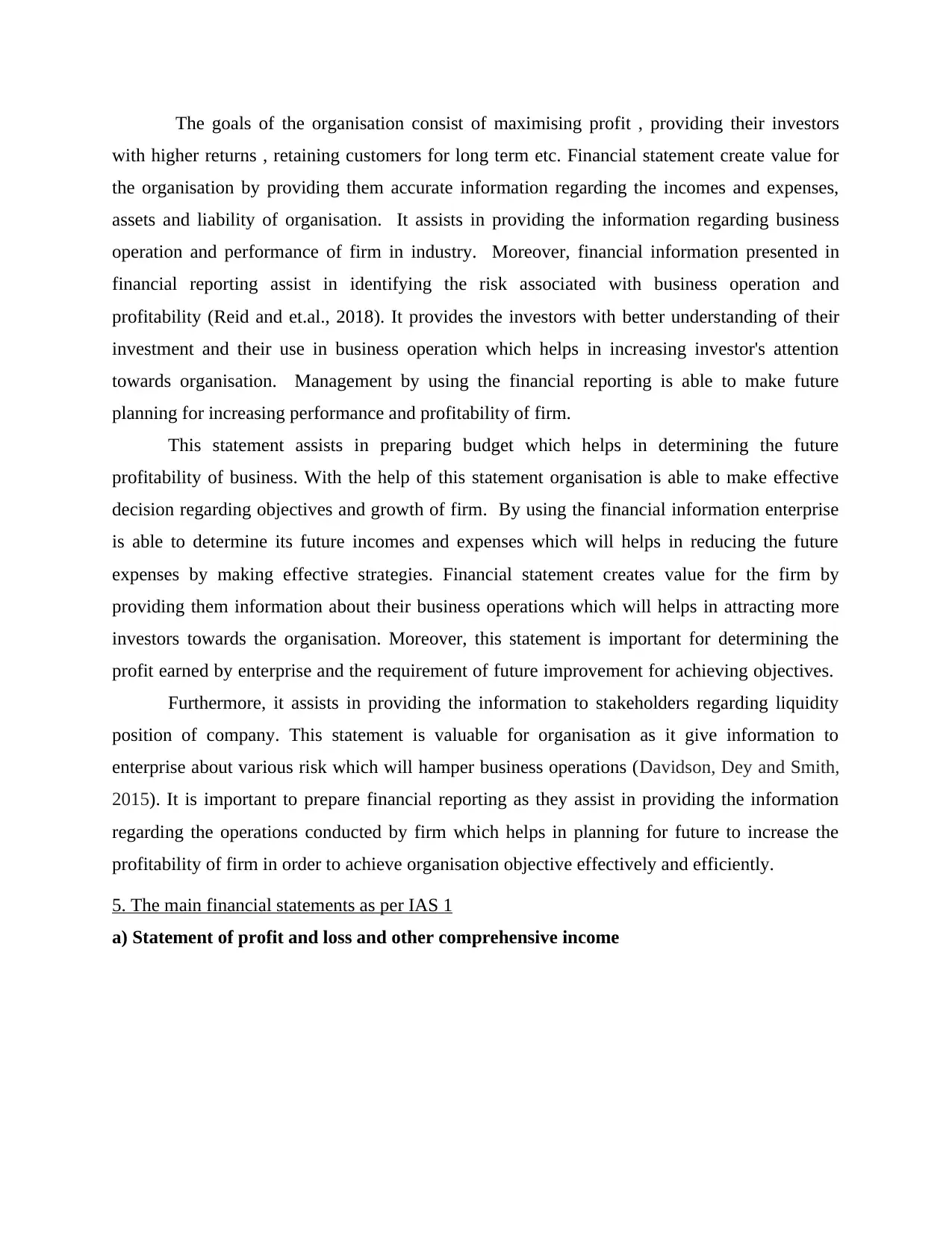
The goals of the organisation consist of maximising profit , providing their investors
with higher returns , retaining customers for long term etc. Financial statement create value for
the organisation by providing them accurate information regarding the incomes and expenses,
assets and liability of organisation. It assists in providing the information regarding business
operation and performance of firm in industry. Moreover, financial information presented in
financial reporting assist in identifying the risk associated with business operation and
profitability (Reid and et.al., 2018). It provides the investors with better understanding of their
investment and their use in business operation which helps in increasing investor's attention
towards organisation. Management by using the financial reporting is able to make future
planning for increasing performance and profitability of firm.
This statement assists in preparing budget which helps in determining the future
profitability of business. With the help of this statement organisation is able to make effective
decision regarding objectives and growth of firm. By using the financial information enterprise
is able to determine its future incomes and expenses which will helps in reducing the future
expenses by making effective strategies. Financial statement creates value for the firm by
providing them information about their business operations which will helps in attracting more
investors towards the organisation. Moreover, this statement is important for determining the
profit earned by enterprise and the requirement of future improvement for achieving objectives.
Furthermore, it assists in providing the information to stakeholders regarding liquidity
position of company. This statement is valuable for organisation as it give information to
enterprise about various risk which will hamper business operations (Davidson, Dey and Smith,
2015). It is important to prepare financial reporting as they assist in providing the information
regarding the operations conducted by firm which helps in planning for future to increase the
profitability of firm in order to achieve organisation objective effectively and efficiently.
5. The main financial statements as per IAS 1
a) Statement of profit and loss and other comprehensive income
with higher returns , retaining customers for long term etc. Financial statement create value for
the organisation by providing them accurate information regarding the incomes and expenses,
assets and liability of organisation. It assists in providing the information regarding business
operation and performance of firm in industry. Moreover, financial information presented in
financial reporting assist in identifying the risk associated with business operation and
profitability (Reid and et.al., 2018). It provides the investors with better understanding of their
investment and their use in business operation which helps in increasing investor's attention
towards organisation. Management by using the financial reporting is able to make future
planning for increasing performance and profitability of firm.
This statement assists in preparing budget which helps in determining the future
profitability of business. With the help of this statement organisation is able to make effective
decision regarding objectives and growth of firm. By using the financial information enterprise
is able to determine its future incomes and expenses which will helps in reducing the future
expenses by making effective strategies. Financial statement creates value for the firm by
providing them information about their business operations which will helps in attracting more
investors towards the organisation. Moreover, this statement is important for determining the
profit earned by enterprise and the requirement of future improvement for achieving objectives.
Furthermore, it assists in providing the information to stakeholders regarding liquidity
position of company. This statement is valuable for organisation as it give information to
enterprise about various risk which will hamper business operations (Davidson, Dey and Smith,
2015). It is important to prepare financial reporting as they assist in providing the information
regarding the operations conducted by firm which helps in planning for future to increase the
profitability of firm in order to achieve organisation objective effectively and efficiently.
5. The main financial statements as per IAS 1
a) Statement of profit and loss and other comprehensive income
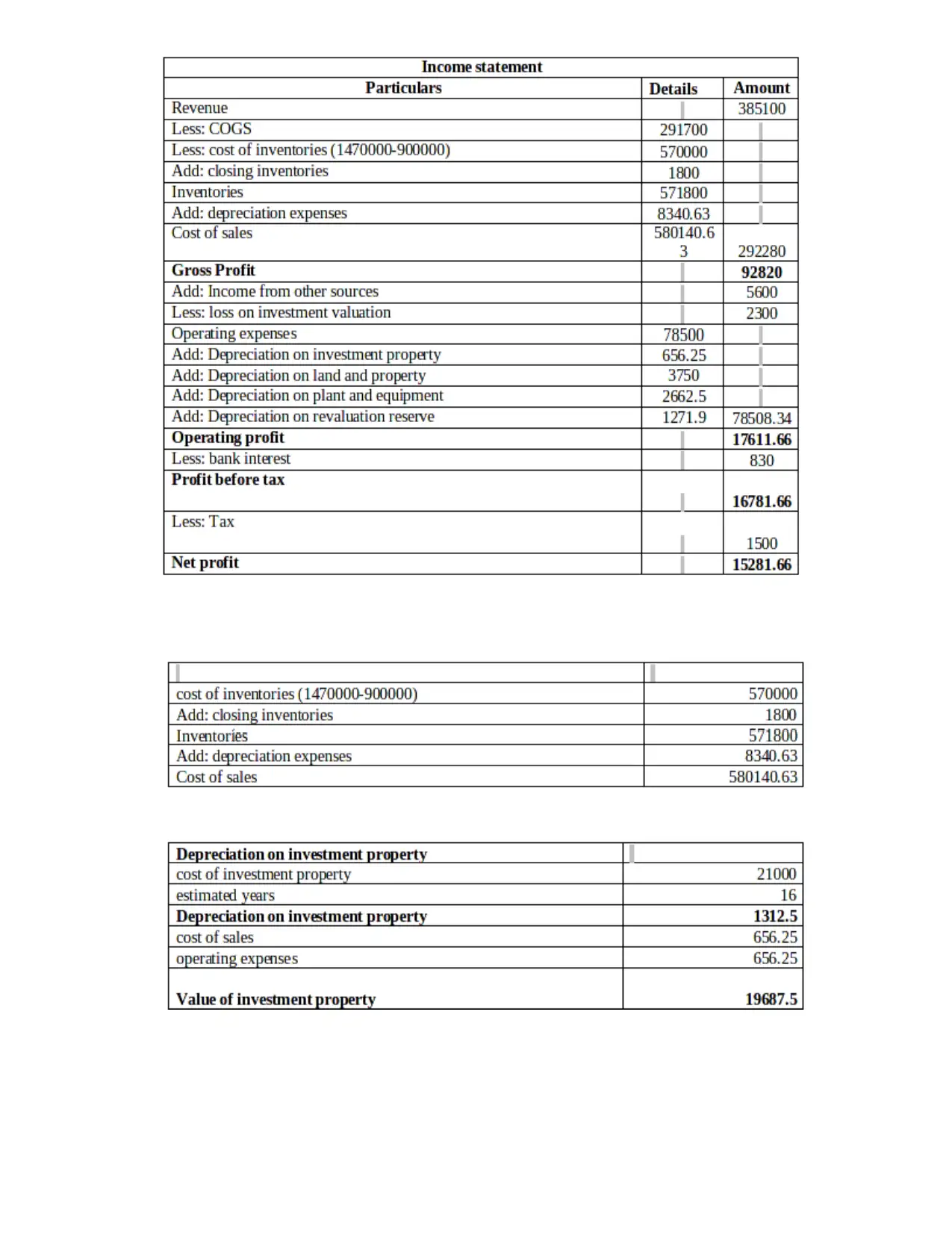
⊘ This is a preview!⊘
Do you want full access?
Subscribe today to unlock all pages.

Trusted by 1+ million students worldwide
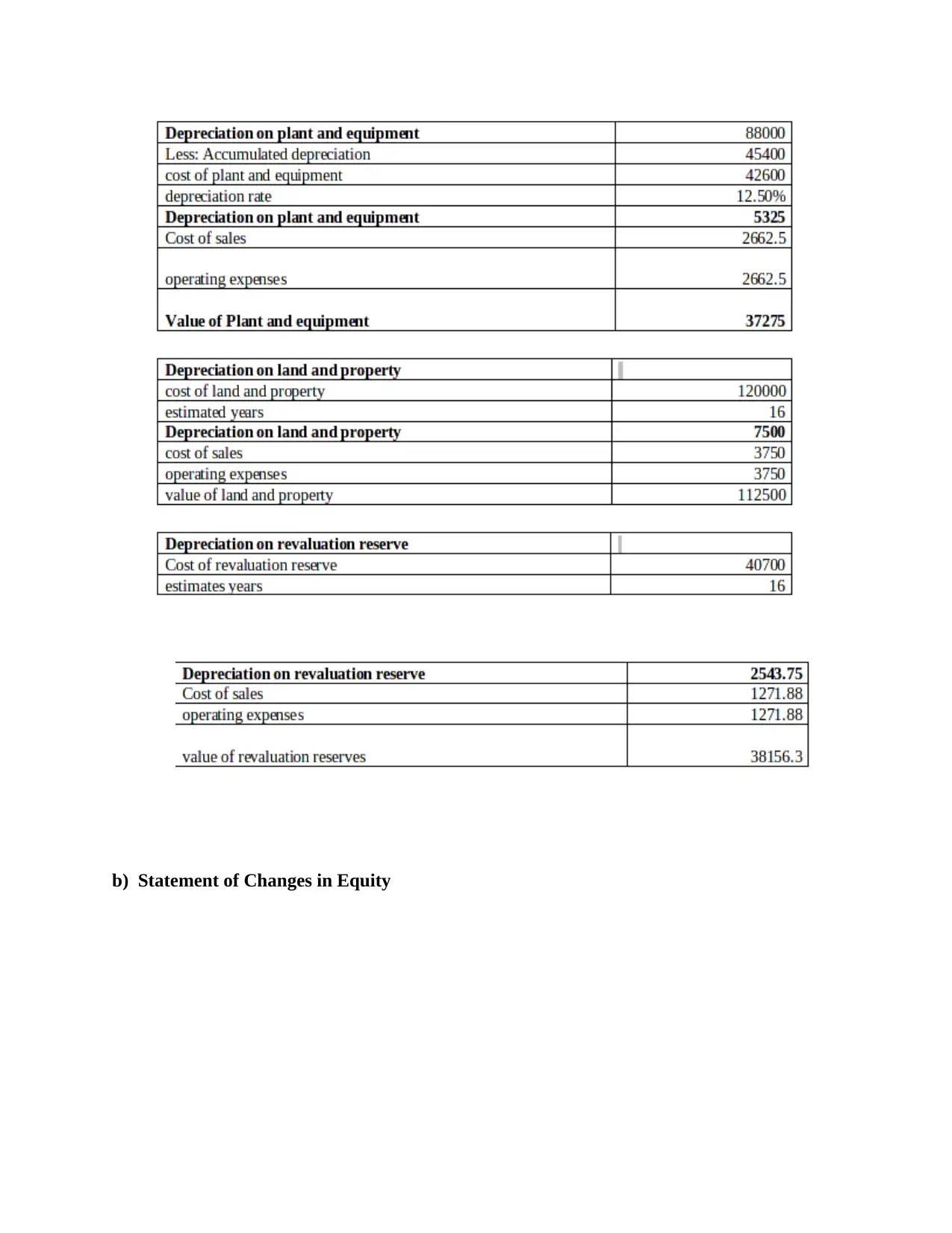
b) Statement of Changes in Equity
Paraphrase This Document
Need a fresh take? Get an instant paraphrase of this document with our AI Paraphraser
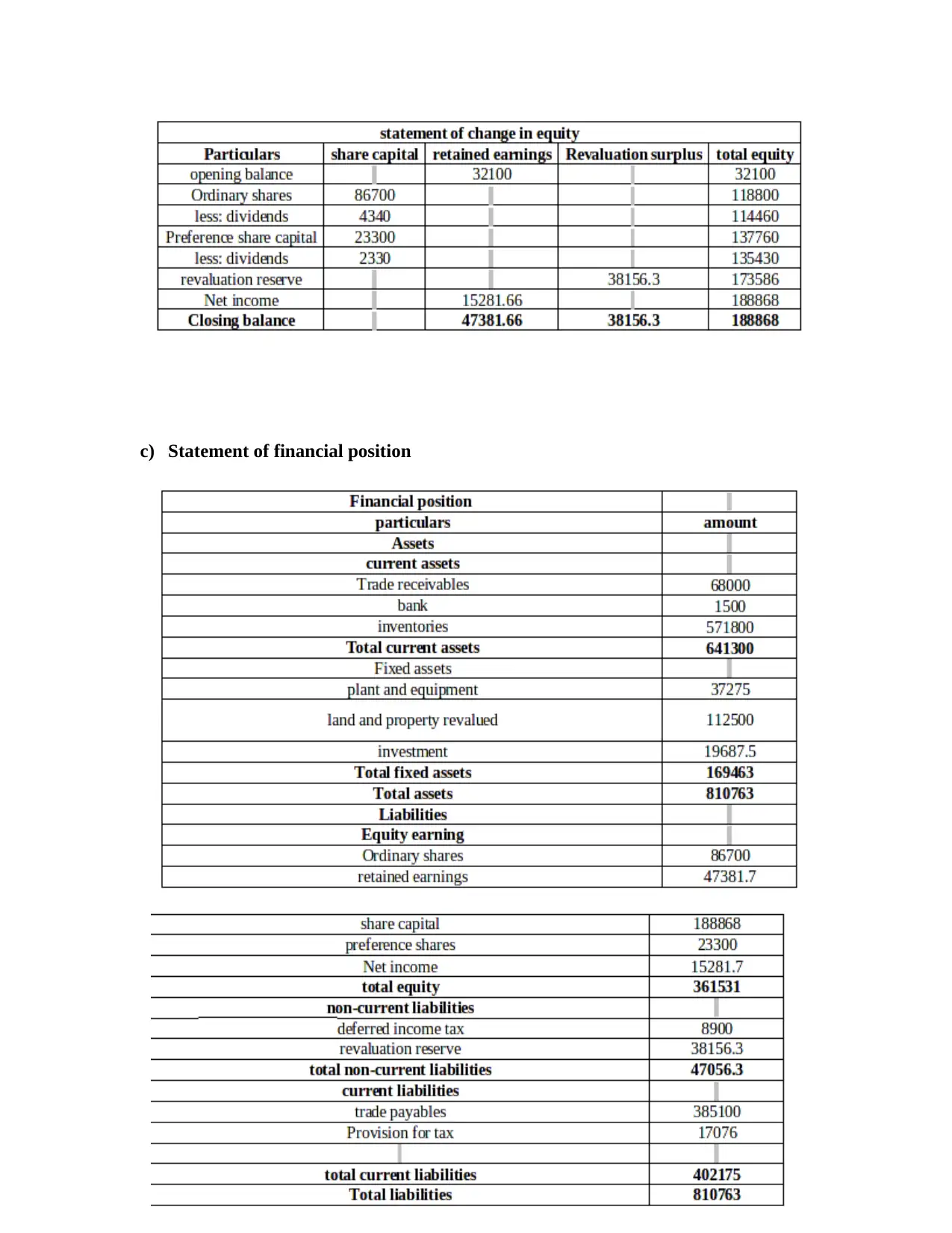
c) Statement of financial position
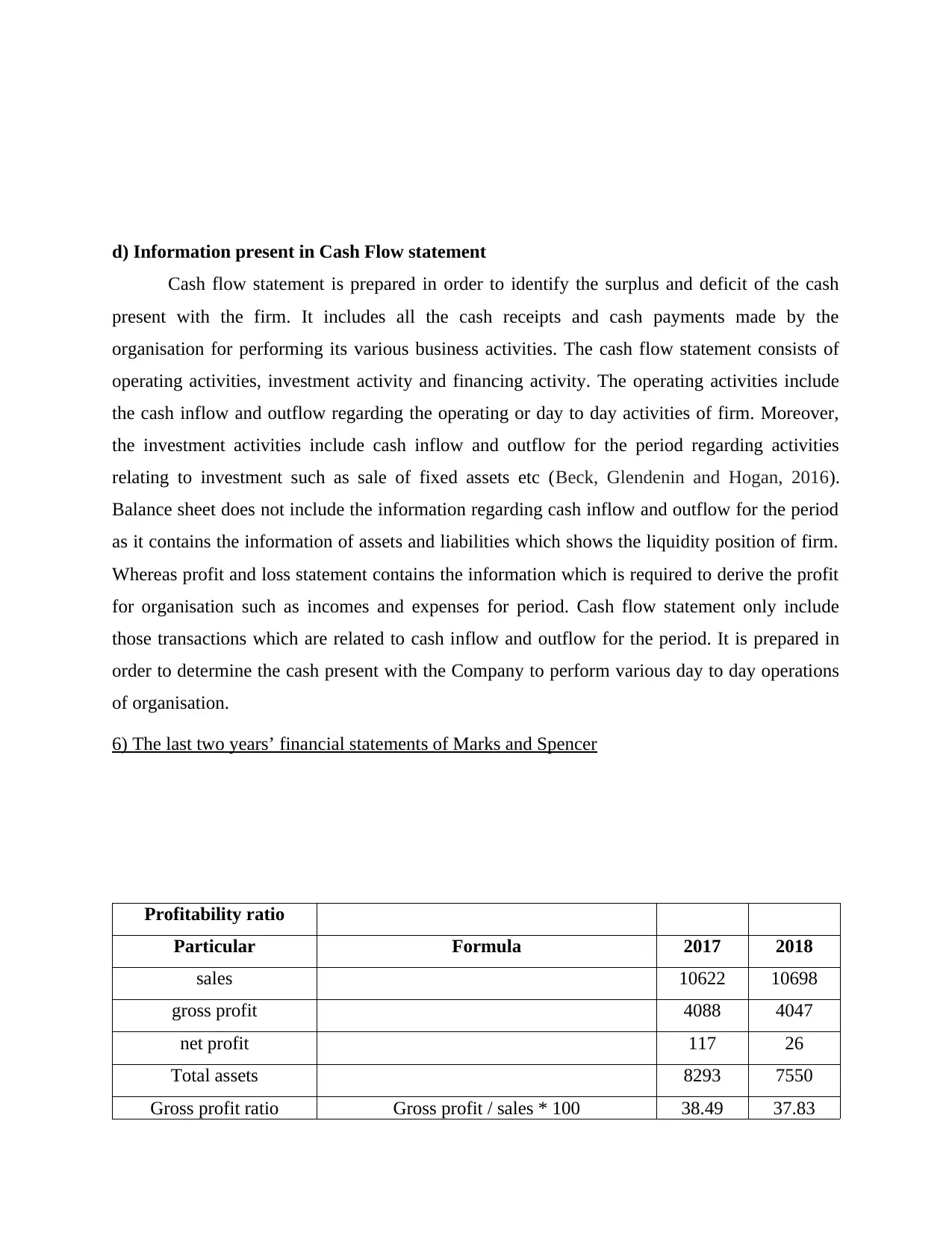
d) Information present in Cash Flow statement
Cash flow statement is prepared in order to identify the surplus and deficit of the cash
present with the firm. It includes all the cash receipts and cash payments made by the
organisation for performing its various business activities. The cash flow statement consists of
operating activities, investment activity and financing activity. The operating activities include
the cash inflow and outflow regarding the operating or day to day activities of firm. Moreover,
the investment activities include cash inflow and outflow for the period regarding activities
relating to investment such as sale of fixed assets etc (Beck, Glendenin and Hogan, 2016).
Balance sheet does not include the information regarding cash inflow and outflow for the period
as it contains the information of assets and liabilities which shows the liquidity position of firm.
Whereas profit and loss statement contains the information which is required to derive the profit
for organisation such as incomes and expenses for period. Cash flow statement only include
those transactions which are related to cash inflow and outflow for the period. It is prepared in
order to determine the cash present with the Company to perform various day to day operations
of organisation.
6) The last two years’ financial statements of Marks and Spencer
Profitability ratio
Particular Formula 2017 2018
sales 10622 10698
gross profit 4088 4047
net profit 117 26
Total assets 8293 7550
Gross profit ratio Gross profit / sales * 100 38.49 37.83
Cash flow statement is prepared in order to identify the surplus and deficit of the cash
present with the firm. It includes all the cash receipts and cash payments made by the
organisation for performing its various business activities. The cash flow statement consists of
operating activities, investment activity and financing activity. The operating activities include
the cash inflow and outflow regarding the operating or day to day activities of firm. Moreover,
the investment activities include cash inflow and outflow for the period regarding activities
relating to investment such as sale of fixed assets etc (Beck, Glendenin and Hogan, 2016).
Balance sheet does not include the information regarding cash inflow and outflow for the period
as it contains the information of assets and liabilities which shows the liquidity position of firm.
Whereas profit and loss statement contains the information which is required to derive the profit
for organisation such as incomes and expenses for period. Cash flow statement only include
those transactions which are related to cash inflow and outflow for the period. It is prepared in
order to determine the cash present with the Company to perform various day to day operations
of organisation.
6) The last two years’ financial statements of Marks and Spencer
Profitability ratio
Particular Formula 2017 2018
sales 10622 10698
gross profit 4088 4047
net profit 117 26
Total assets 8293 7550
Gross profit ratio Gross profit / sales * 100 38.49 37.83
⊘ This is a preview!⊘
Do you want full access?
Subscribe today to unlock all pages.

Trusted by 1+ million students worldwide
1 out of 21
Related Documents
Your All-in-One AI-Powered Toolkit for Academic Success.
+13062052269
info@desklib.com
Available 24*7 on WhatsApp / Email
![[object Object]](/_next/static/media/star-bottom.7253800d.svg)
Unlock your academic potential
Copyright © 2020–2025 A2Z Services. All Rights Reserved. Developed and managed by ZUCOL.





